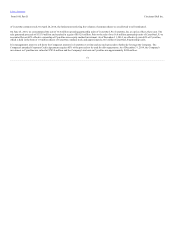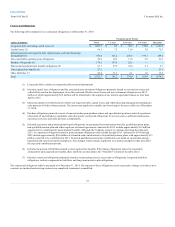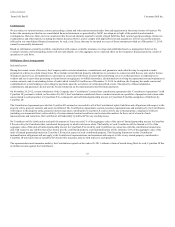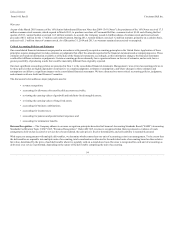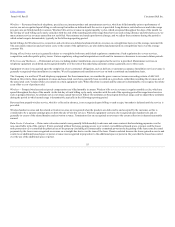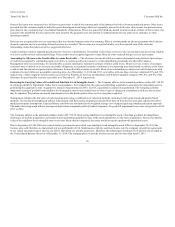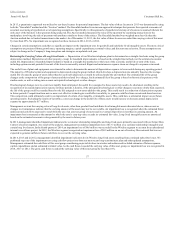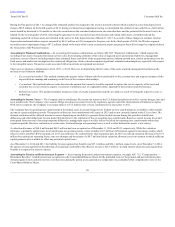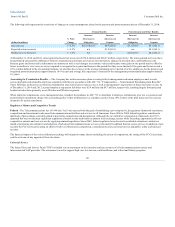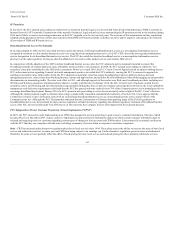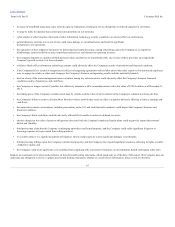Cincinnati Bell 2014 Annual Report Download - page 61
Download and view the complete annual report
Please find page 61 of the 2014 Cincinnati Bell annual report below. You can navigate through the pages in the report by either clicking on the pages listed below, or by using the keyword search tool below to find specific information within the annual report.
Table of Contents
Form 10-K Part II
Cincinnati Bell Inc.
In October 2011 the FCC adopted new rules (Report and Order in WC Docket No. 10-90, FCC 11-161, the "Order") aimed at controlling the size of the high-
cost portion of the fund and transitioning it from supporting legacy circuit-switched networks to broadband. The Order capped the high-cost fund and
established a framework for transitioning support to the new Connect America Fund ("CAF") to bring broadband to unserved areas. Phase I reforms froze
existing high-cost support and provided a mechanism for distributing additional support for price cap companies. Under Phase II, $1.8 billion of annual
support will be available for areas served by price cap ILECs. The cost model that will be used to set the Phase II support amounts for each price cap area has
been finalized and the FCC is expecting to announce support amounts for eligible price cap carriers in early 2015. Price cap ILECs will have the right of first
refusal for the support. If the price cap carrier declines to make the state-level commitment associated with the support, the support will be distributed via a
competitive bidding process. Once the Phase II support is available, the Phase I support will be phased out and carriers accepting the Phase II commitment
will have the funds available for a six year period. The price cap carrier changes adopted in 2011 froze CBT's high cost support at approximately $0.8
million. CBT is eligible to receive this frozen support until the Phase II program is implemented. CBT anticipates it will be eligible for approximately $2
million in Phase II support beginning in 2015 if it chooses to accept it.
During 2013 the FCC took several steps to reform the low income support program adopted in 2012 in order to control the cost of this portion of the fund.
The reforms, aimed primarily at eliminating waste, fraud and abuse in the Lifeline program require participating carriers to access the National Lifeline
Accountability Database before enrolling any new Lifeline subscribers. Until July 1, 2014 both CBT and CBW participated in the Lifeline program.
However, effective July 1, 2014, CBW relinquished its eligible telecommunications carrier status and withdrew from the Lifeline program. CBT remains a
Lifeline provider and currently serves approximately 5,500 Lifeline customers.
During 2014 the FCC adopted two orders reforming the Schools and Libraries component of the Universal Service Fund. The first order adopted a plan for
phasing out support for voice services and allotted $1 billion per year for the next two years for funding Wi-Fi and other services to provide connectivity
within schools and libraries. The second order, adopted in late 2014, increased the cap on the Schools and Libraries fund to $3.9 billion per year. These
decisions may result in changes in the mix of services schools and libraries purchase from the Company and will increase the USF assessment on carriers to
pay for the increased funding levels. However, because the assessments are generally fully passed on to consumers, the increased assessment should be
neutral for the Company.
Intercarrier Compensation
In October 2011, in conjunction with its reform of the USF high cost support program, the FCC adopted comprehensive reforms to the switched access and
reciprocal compensation rules which govern the means by which carriers compensate one another for use of their networks. The end point of the reforms is a
bill-and-keep system under which all per-minute intercarrier charges are eliminated.
Beginning in 2012, terminating switched access and reciprocal compensation rates are being phased out over a six-year period for CBT and other price cap
carriers and over a nine-year period for rate-of-return carriers. The plan establishes a mechanism whereby ILECs are permitted to recover some of the lost
revenue from increased end-user charges and support from the newly created Connect America Fund. The transition and recovery mechanism for originating
access and transport rates has not yet been established by the FCC. The impact of these reforms for the Company will primarily fall on CBT. The impact of the
reforms will increase each year during the six-year transition to bill-and-keep. The Company's terminating switched access and reciprocal compensation
revenue subject to these rules was estimated to be less than $7 million in total, and will be phased out to zero over the six-year transition period. The
potential to offset these losses via increased end-user charges will primarily depend on competitive conditions in the ILEC operating area.
Special Access
In 2005, the FCC opened a proceeding to review the current special access pricing rules. Under the existing rules, special access services are subject to price
cap regulation with no earnings cap, and ILECs are entitled to pricing flexibility in metropolitan statistical areas served by a sufficient number of
competitors. The special access review proceeding examines the entire special access pricing structure, including whether or not to reinstate an earnings cap
and whether the pricing flexibility rules should be modified. During 2012, the FCC suspended the grant of any new pricing flexibility requests and issued a
mandatory data request. Responses to the data request are due in the first quarter of 2015 and will be analyzed by the FCC. The impact of any action by the
FCC in this proceeding is still uncertain and likely several years away.
61


